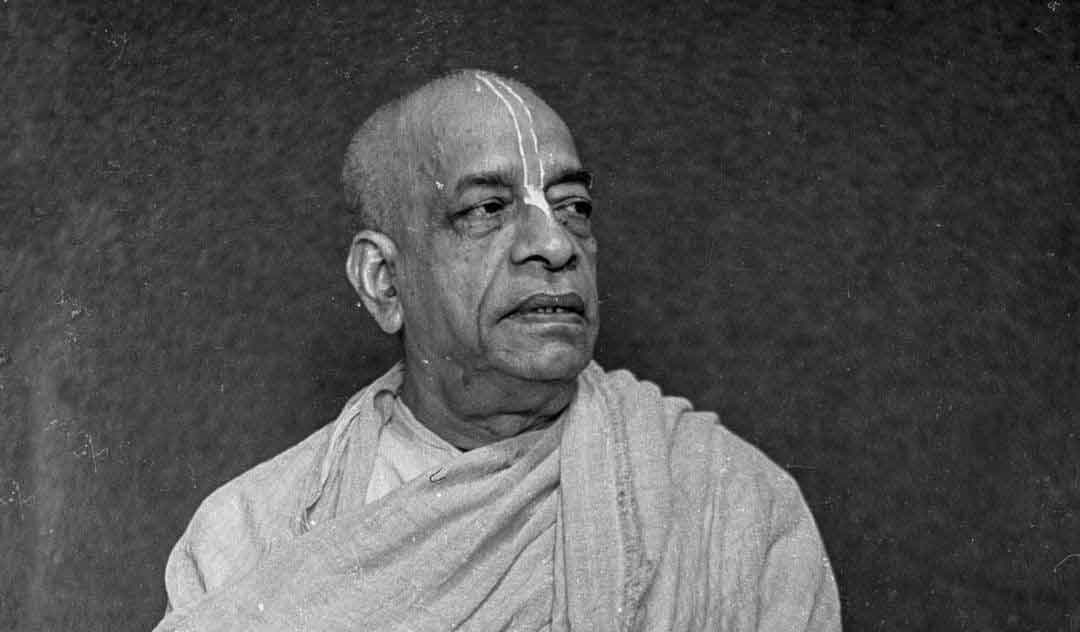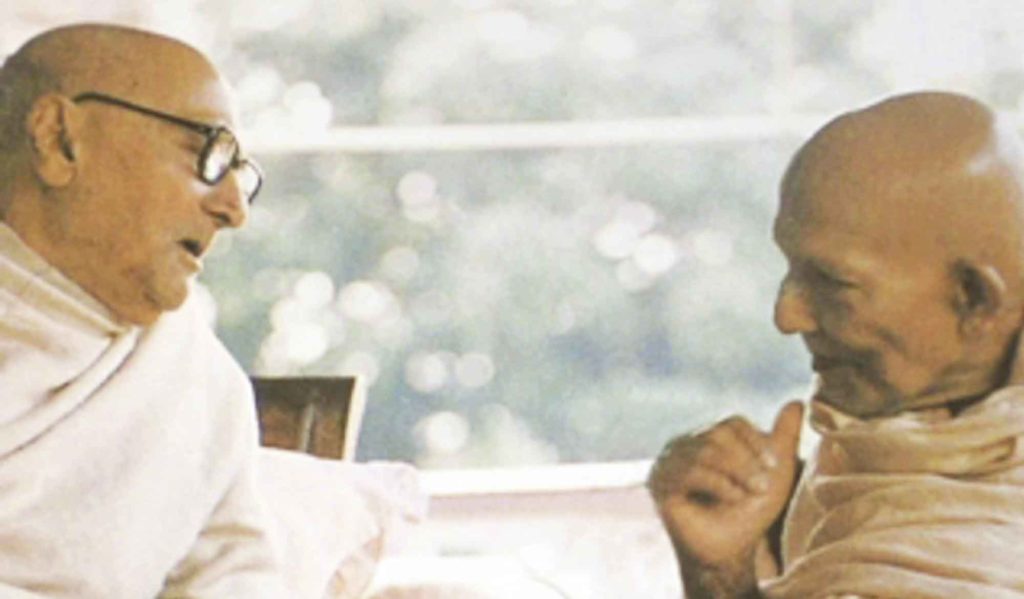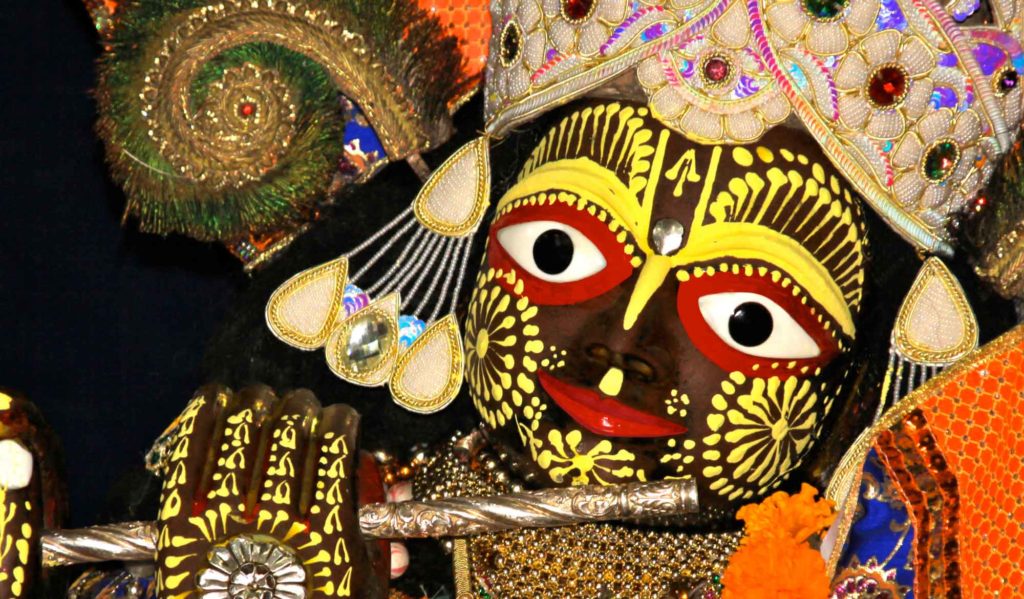Overview
This tribute to Śrīla A.C. Bhaktivedānta Swami Prabhupāda by Śrīla B.P. Purī Gosvāmī was originally published in Caitanya Vāṇī magazine in November 1977. In this article Śrīla Purī Mahārāja glorifies Prabhupāda's achievements and gives a brief synopsis of his life. This article was translated by Swami B.V. Giri and Sanātana Dāsa.
Tridaṇḍi-swami Śrīmad Bhaktivedanta Swami Mahārāja (Śrīla A.C. Bhaktivedanta Swami Prabhupada), Founder-Ācārya of the world famous International Society for Kṛṣṇa Consciousness, attained the dust of Vraja at the age of 81 on Monday 14th November (corresponding to the 19th day of the month of Dāmodara, 491 Gaurābda, on the Śukla Caturthī) in the evening at 7:20 pm in his Kṛṣṇa-Balarāma Temple situated in Śrīdhāma Vṛndāvana, surrounded by his disciples loudly performing saṅkīrtana, while remembering the lotus feet of Śrī Śrī Guru-Gaurāṅga Gāndharvikā-Giridhārī Jiu.
On 15th November at 12:00 noon, the ācārya of Śrī Caitanya Gauḍīya Maṭha (Śrīpāda Bhakti Dayita Mādhava Mahārāja) was informed of the news by telephone by the Kolkata branch of ISKCON in Albert Road. Hearing it, he was very much mortified and immediately sent a telegram to Śrī Śrī Kṛṣṇa-Balarāma Temple in Vṛndāvana expressing his sincere respects and condolences.
That night, Pūjyapāda Mādhava Mahārāja, while lecturing on the Śrīmad Bhagavata, related briefly Śrīpāda Swami Mahārāja’s life history and the news of his disappearance to the audience. Also on the next day, on Wednesday evening, while speaking on the Bhāgavata, Pūjyapāda Mādhava Mahārāja expressed his pain of separation for his godbrother Swami Mahārāja and highly praised his worldwide preaching of the message of Śrī Caitanya within a very short span of time. He further revealed the specialty that his foreign disciples have – completely changing their dress code, food, dietary habits and etiquette, and welcoming all Vaiṣṇava behaviour such as accepting a humble dress befitting a Gauḍīya Vaiṣṇava, accepting bhāgavat-prasāda, wearing tulasī beads around the neck, keeping japa-mālā in their hands, decorating their limbs with gopī-candana etc, and without any inhibition incessantly performing mahā-mantra kīrtana, studying devotional scriptures and worshipping the śrī-vigraha. All this is very happy news.
Śrīmad Swami Mahārāja took birth in the English year 1896 in a devotee family in Kolkata. The name of his father from his previous āśrama was Gaura-mohan De. His father gave him the name, Abhay Charan De. His father was initiated into the Gauḍīya Vaiṣṇava dharma. Abhay Charan also received many instructions on devotion to Śrī Gaura-Kṛṣṇa from his revered father. He passed B.A with honours in Philosophy from Scottish Church College in Kolkata. Later in his working life, he took the position of manager in a chemical company (Dr Karttik Basu’s laboratory in Amherst Street). After working there for some time, he started independently manufacturing medicines. He was married in the year 1918, and in 1933, while in the gṭhastha āśrama, he accepted the shelter of the holy feet of the sun-like ācārya of the Gauḍīya-Vaiṣṇavas Jagad-guru Nitya-līlā-praviṣṭa Oṁ Viṣṇupāda 108 Śrī Śrīmad Bhaktisiddhānta Sarasvatī Gosvāmī Ṭhākura. His initiated name became Śrī Abhaya-caraṇārvinda Dāsa Adhikārī.
In the year 1959, he took shelter of tridaṇḍi sannyāsa-veśa from the disciple of the worshippable Śrī Śrīla Sarasvatī Gosvāmī Ṭhākura, the ācārya of Śrī Gauḍīya Vedānta Samiti in Navadvīpa, Tridaṇḍi Swami Śrīmad Bhakti Prajñāna Keśava Mahārāja and came to be known as Tridaṇḍi Swami Bhaktivedānta Swami Mahārāja. Later, he identified himself as Śrī A.C Bhaktivedanta Swami Mahārāja.
In the year 1944, he published a monthly magazine in English called, Back to Godhead. This magazine is now widely circulated. In various languages millions of copies are sent every month to devotees in various countries. Apart from this, Śrīmad Swami Mahārāja has published many books in English. He has written each and every stanza of Śrī Caitanya-caritāmṛta by Śrīla Kṛṣṇa Dāsa Kavirāja Gosvāmī in Bengali and again transliterated them into English. Then, the way in which he gave the meaning of every word in English and the mastery with which he again translated the entire stanza to English is a matter of special jubilation for any Gauḍīya Vaiṣṇava. English speaking devotees very much appreciate this edition as they also have the opportunity to learn the Bengali language while reading that book. The book has been published in several parts. I have heard that its price has been fixed to Rs. 800. In this way, all of his books written about gaura-līlā and kṛṣṇa-līlā have been specially honoured by the intelligentsia of the western world.
In the year 1956, Śrīla Swami Mahārāja came to Śrīdhāma Vṛndāvana and eventually stayed at Śrī Śrī Rādhā-Dāmodara Temple in 1959. During this time, he translated the first two cantos of Śrīmad Bhagavata into English. The translation of books such as the Gita also continued. In the year 1965 at the age of 70, he started for the United States with very little money and means. After one year, he rented a small room in Manhattan in 26 Second Avenue and auspiciously started ISKCON there. At first, he went to New York City via Boston and started preaching the holy name with the accompaniment of mṛdaṅga at Tompkins Square Park. Slowly, good people became attracted to his mission in large numbers. Within just 12 years his preaching spread in all corners of the world. Many educated and wealthy men and women took shelter under him. One by one many preaching centres were established in different parts of the world and the chanting of the holy name reverberated in the sky. After giving the responsibility of managing his spiritual organisation and preaching mission to his disciples, he left for the eternal abode.
There is special plan to construct a 250-foot temple at the Śrī Māyāpura Candrodaya Temple established by him at Śrīdhāma Māyāpura. I hope that his most qualified disciples will soon endeavor diligently in every way possible to fulfil their spiritual master’s desire. Śrīman Mahāprabhu’s desire was:
pṛthivīte āche yata nagarādi grāma
sarvatra pracāra haibe mora nāma
“In every town and village of the world the holy name will be chanted.” (Caitanya-bhāgavata)
Śrī Gaura’s very own associate Śrīla Ṭhākura Bhaktivinoda and Śrī Śrīla Prabhupāda Bhaktisiddhānta Sarasvatī Ṭhākura also had such a special desire and predicted that the message of Śrī Caitanya would be preached in England. Śrīla Swami Mahārāja especially endeavoured to fulfil their desire in every way. It is a matter of great pride for us that various sevās such as the Deity service of Śrī Śrī Guru-Gaurāṅga Gāndharvikā-Giridhārī Jiu and festivals like jhulana, Dola-yātrā etc, as well as the Ratha-yātrā of Śrī Śrī Jagannātha, Baladeva and Subhadrā Jiu are being celebrated in various elite places on continents like Europe and America. Altogether, we are praying at the lotus feet of Bhagavān that the service activities in the organisation established by Śrīla Swami Mahārāja will be managed beautifully with more and more enthusiasm.
Śrīla Swami Mahārāja fell ill since the last Dola Pūrṇimā, but even still, in that condition, he travelled to foreign countries in order to visit his various temples located there. In the last September month, he went to London. By the desire of Śrī Bhagavān he began staying in Śrī Vṛndāvana from October. There he obtained the mercy of Śrī Śrī Vṛndāvaneśvarī.
Śrīpāda Kṛṣṇa Dāsa Bābājī Mahāśaya fortunately arrived at Śrī Caitanya Gauḍīya Maṭha in Kolkata on 20th November 1977. He was present in Śrī Vṛndāvana when Śrīmad Swami Mahārāja was leaving his body. From him we heard that the disciples of Śrīpāda Swami Mahārāja were tirelessly chanting hari-nāma surrounding his bed on four sides. Although Swami Mahārāja had stopped speaking, till the last moment his lips were moving. When Vaiṣṇavas like Śrīpāda Vana Mahārāja and Kṛṣṇa Dāsa Bābājī Mahārāja came to have his darśana, his disciples loudly announced their identity near his ears and he raised his holy hand to his head to show his respect towards them. Even till the last moment of his disappearance his knowledge did not falter. Even after the pastime of his disappearance, his disciples chanted the holy name loudly throughout the whole night. On the Tuesday morning of Śukla-Pañcamī, he was carried in a decorated palanquin and, accompanied by loud nāma-saṅkīrtana, circumambulated the famous seven temples of Vṛndāvana. Every head gosvāmī showed him proper respect befitting a Vaiṣṇava ācārya by offering him prasāda-garlands and sandalwood paste. After that, he was taken to his Kṛṣṇa-Balārama Temple situated in Ramaṇa-reti and given samādhi as per the standard of śāstra.
Related Articles
- The True Spirit of Separation by Śrīla Bhakti Pramoda Purī Gosvāmī
- Śrīla Swami Mahārāja Attains the Dust of Vraja by Śrīla Bhakti Pramoda Purī Gosvāmī
- The Disappearance of Śrīla Śrīdhara Mahārāja by Śrīla Bhakti Pramoda Purī Gosvāmī
- Who is Qualified to Succeed the Ācārya? by Śrīla Bhakti Rakṣaka Śrīdhara Deva Gosvāmī
- Śrīla Sarasvatī Ṭhākura’s Disappearance Day by Śrīla Bhakti Rakṣaka Śrīdhara Deva Gosvāmī
- His Last Instructions by Śrīla Bhakti Gaurava Narasiṅgha Mahārāja
- The Prākṛta and Aprākṛta-līlā of Śrī Guru by Śrīla Bhakti Gaurava Narasiṅgha Mahārāja
- Śrīla Prabhupāda’s Antya-līlā by Śrīla Bhakti Gaurava Narasiṅgha Mahārāja
- Śrīla Sarasvatī Ṭhākura’s Disappearance Day by Śrīla Bhakti Gaurava Narasiṅgha Mahārāja
- Śrī Jagannātha Deva Shook the Heaven and the Earth by Śrīla Bhakti Gaurava Narasiṅgha Mahārāja
- After the Disappearance of Śrī Guru by Śrīla Bhakti Gaurava Narasiṅgha Mahārāja
- A Nourishing and Compassionate Nature by Śrīla Bhakti Kiśora Āraṇya Mahārāja
- The Compassionate Nature of Śrī Guru by Śrīla Bhakti Kiśora Āraṇya Mahārāja
- Hope For The Hopeless by Śrīla Bhakti Kiśora Āraṇya Mahārāja
- The Disappearance of Śrīla Bhakti Gaurava Narasiṅgha Mahārāja by Swami B.V. Giri
Further Reading
Prema Dhāma Deva Stotram with the Narasiṅgha Sevaka Commentary – Verses 61-65
In verses 61 to 65 of 'Prema Dhāma Deva Stotram', Śrīla Śrīdhara Mahārāja narrates the pastime of Śrī Caitanya at Caṭaka Parvata In Purī and explains how the scriptures produced by Brahmā and Śiva are ultimately searching for the personality of Mahāprabhu who is merciful too all jīvas, no matter what their social position.
Prabhupāda Śrīla Sarasvatī Ṭhākura’s Visit to Ayodhyā
With the forthcoming observance of Śrī Rāma Navamī, we present 'Prabhupāda Śrīla Sarasvatī Ṭhākura’s Visit to Ayodhyā' written by Śrīla Bhaktisiddhānta Sarasvatī Ṭhākura Prabhupāda from The Gaudīyā magazine, Vol 3. Issue 21/ In December 1924, after visiting Benares and Prāyāga, Sarasvatī Ṭhākura visited the birth-site of Śrī Rāmācandra in Ayodhyā.
Śaraṇāgati – The Only Path to Auspiciousness
In this article, 'Śaraṇāgati - The Only Path to Auspiciousness', Dhīra Lalitā Dāsī analyses the process of śaraṇāgati (surrender) beginning with śraddhā (faith). She also discusses the role of śāstra and the Vaiṣṇava in connection with surrender.
Ātma Samīkṣā – The Value of Introspection
In this article, "Ātma Samīkṣā – The Value of Introspection" Kalki Dāsa highlights the importance of introspection in the life of a devotee and especially in relation to the worldly environment that surrounds us. He also explains how transcendental sound influences our capacity to introspect.
Prema Dhāma Deva Stotram with the Narasiṅgha Sevaka Commentary – Verses 61-65
In verses 61 to 65 of 'Prema Dhāma Deva Stotram', Śrīla Śrīdhara Mahārāja narrates the pastime of Śrī Caitanya at Caṭaka Parvata In Purī and explains how the scriptures produced by Brahmā and Śiva are ultimately searching for the personality of Mahāprabhu who is merciful too all jīvas, no matter what their social position.
Prabhupāda Śrīla Sarasvatī Ṭhākura’s Visit to Ayodhyā
With the forthcoming observance of Śrī Rāma Navamī, we present 'Prabhupāda Śrīla Sarasvatī Ṭhākura’s Visit to Ayodhyā' written by Śrīla Bhaktisiddhānta Sarasvatī Ṭhākura Prabhupāda from The Gaudīyā magazine, Vol 3. Issue 21/ In December 1924, after visiting Benares and Prāyāga, Sarasvatī Ṭhākura visited the birth-site of Śrī Rāmācandra in Ayodhyā.
Śaraṇāgati – The Only Path to Auspiciousness
In this article, 'Śaraṇāgati - The Only Path to Auspiciousness', Dhīra Lalitā Dāsī analyses the process of śaraṇāgati (surrender) beginning with śraddhā (faith). She also discusses the role of śāstra and the Vaiṣṇava in connection with surrender.
Ātma Samīkṣā – The Value of Introspection
In this article, "Ātma Samīkṣā – The Value of Introspection" Kalki Dāsa highlights the importance of introspection in the life of a devotee and especially in relation to the worldly environment that surrounds us. He also explains how transcendental sound influences our capacity to introspect.








